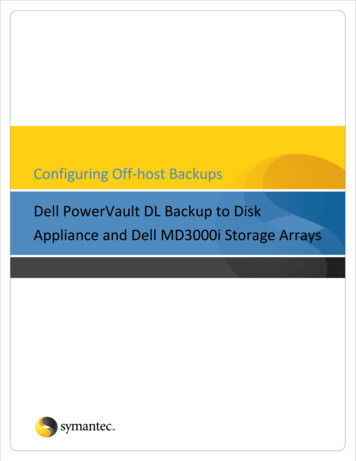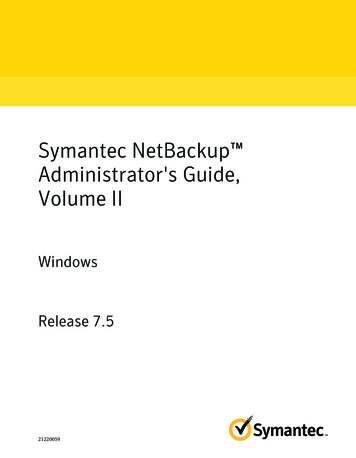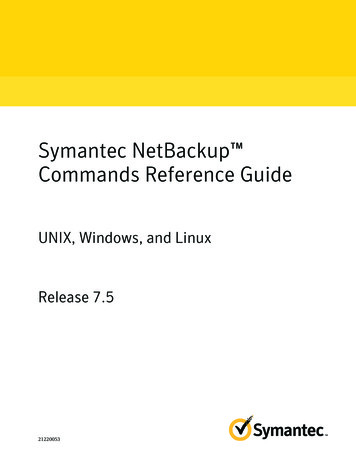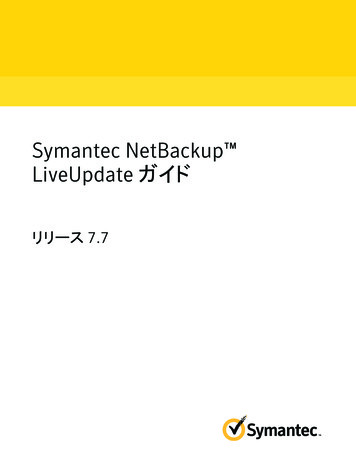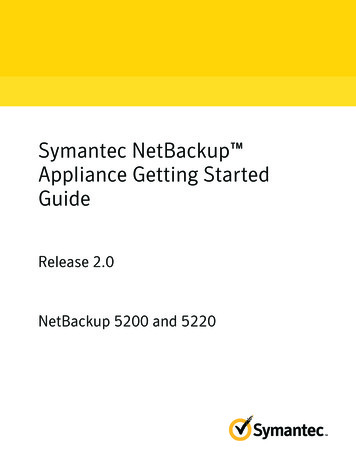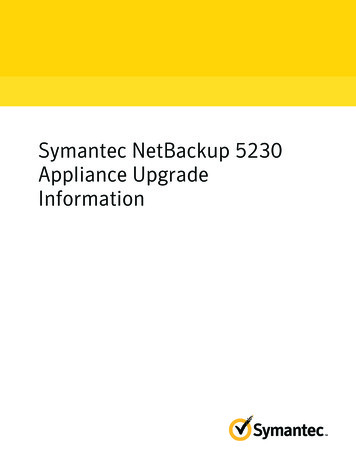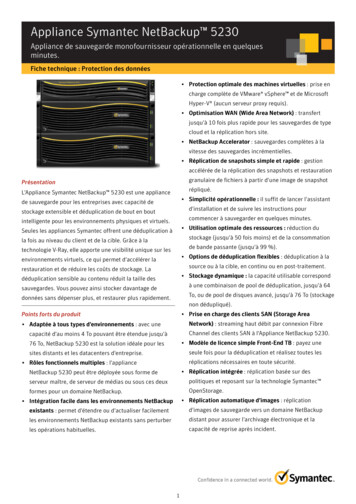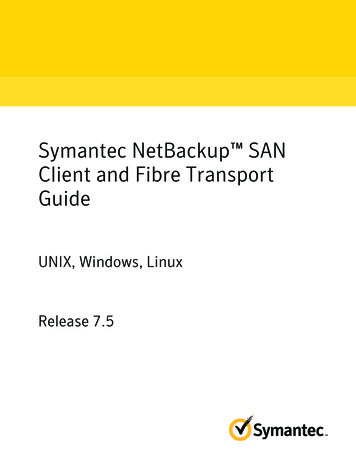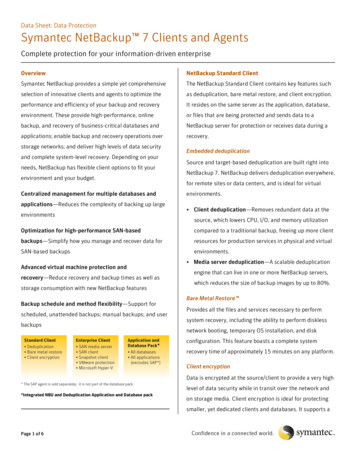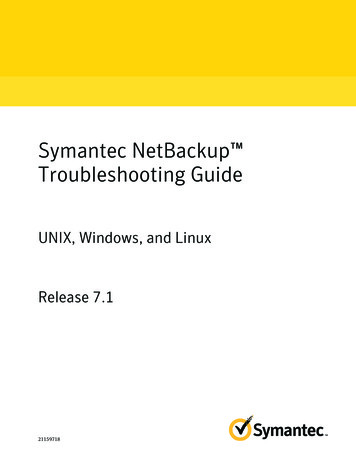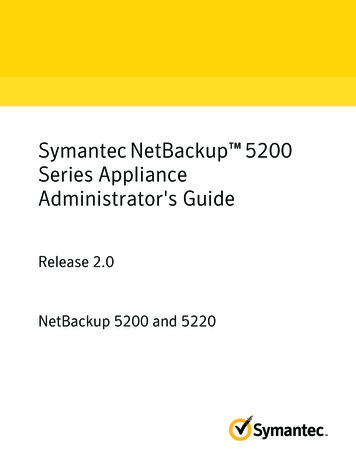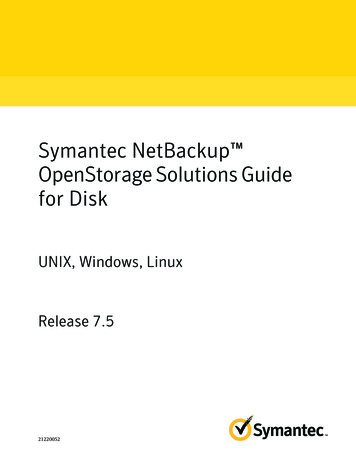
Transcription
Symantec NetBackup OpenStorage Solutions Guidefor DiskUNIX, Windows, LinuxRelease 7.521220052
Symantec NetBackup OpenStorage Solutions Guidefor DiskThe software described in this book is furnished under a license agreement and may be usedonly in accordance with the terms of the agreement.Documentation version: 7.5PN: 21220052Legal NoticeCopyright 2012 Symantec Corporation. All rights reserved.Symantec and the Symantec Logo, Veritas, and NetBackup are trademarks or registeredtrademarks of Symantec Corporation or its affiliates in the U.S. and other countries. Othernames may be trademarks of their respective owners.This Symantec product may contain third party software for which Symantec is requiredto provide attribution to the third party (“Third Party Programs”). Some of the Third PartyPrograms are available under open source or free software licenses. The License Agreementaccompanying the Software does not alter any rights or obligations you may have underthose open source or free software licenses. Please see the Third Party Legal Notice Appendixto this Documentation or TPIP ReadMe File accompanying this Symantec product for moreinformation on the Third Party Programs.The product described in this document is distributed under licenses restricting its use,copying, distribution, and decompilation/reverse engineering. No part of this documentmay be reproduced in any form by any means without prior written authorization ofSymantec Corporation and its licensors, if any.THE DOCUMENTATION IS PROVIDED "AS IS" AND ALL EXPRESS OR IMPLIED CONDITIONS,REPRESENTATIONS AND WARRANTIES, INCLUDING ANY IMPLIED WARRANTY OFMERCHANTABILITY, FITNESS FOR A PARTICULAR PURPOSE OR NON-INFRINGEMENT,ARE DISCLAIMED, EXCEPT TO THE EXTENT THAT SUCH DISCLAIMERS ARE HELD TOBE LEGALLY INVALID. SYMANTEC CORPORATION SHALL NOT BE LIABLE FOR INCIDENTALOR CONSEQUENTIAL DAMAGES IN CONNECTION WITH THE FURNISHING,PERFORMANCE, OR USE OF THIS DOCUMENTATION. THE INFORMATION CONTAINEDIN THIS DOCUMENTATION IS SUBJECT TO CHANGE WITHOUT NOTICE.The Licensed Software and Documentation are deemed to be commercial computer softwareas defined in FAR 12.212 and subject to restricted rights as defined in FAR Section 52.227-19"Commercial Computer Software - Restricted Rights" and DFARS 227.7202, "Rights inCommercial Computer Software or Commercial Computer Software Documentation", asapplicable, and any successor regulations. Any use, modification, reproduction release,performance, display or disclosure of the Licensed Software and Documentation by the U.S.Government shall be solely in accordance with the terms of this Agreement.
Symantec Corporation350 Ellis StreetMountain View, CA 94043http://www.symantec.comPrinted in the United States of America.10 9 8 7 6 5 4 3 2 1
Technical SupportSymantec Technical Support maintains support centers globally. TechnicalSupport’s primary role is to respond to specific queries about product featuresand functionality. The Technical Support group also creates content for our onlineKnowledge Base. The Technical Support group works collaboratively with theother functional areas within Symantec to answer your questions in a timelyfashion. For example, the Technical Support group works with Product Engineeringand Symantec Security Response to provide alerting services and virus definitionupdates.Symantec’s support offerings include the following: A range of support options that give you the flexibility to select the rightamount of service for any size organization Telephone and/or Web-based support that provides rapid response andup-to-the-minute information Upgrade assurance that delivers software upgrades Global support purchased on a regional business hours or 24 hours a day, 7days a week basis Premium service offerings that include Account Management ServicesFor information about Symantec’s support offerings, you can visit our Web siteat the following URL:www.symantec.com/business/support/All support services will be delivered in accordance with your support agreementand the then-current enterprise technical support policy.Contacting Technical SupportCustomers with a current support agreement may access Technical Supportinformation at the following URL:www.symantec.com/business/support/Before contacting Technical Support, make sure you have satisfied the systemrequirements that are listed in your product documentation. Also, you should beat the computer on which the problem occurred, in case it is necessary to replicatethe problem.When you contact Technical Support, please have the following informationavailable: Product release level
Hardware information Available memory, disk space, and NIC information Operating system Version and patch level Network topology Router, gateway, and IP address information Problem description: Error messages and log files Troubleshooting that was performed before contacting Symantec Recent software configuration changes and network changesLicensing and registrationIf your Symantec product requires registration or a license key, access our technicalsupport Web page at the following URL:www.symantec.com/business/support/Customer serviceCustomer service information is available at the following URL:www.symantec.com/business/support/Customer Service is available to assist with non-technical questions, such as thefollowing types of issues: Questions regarding product licensing or serialization Product registration updates, such as address or name changes General product information (features, language availability, local dealers) Latest information about product updates and upgrades Information about upgrade assurance and support contracts Information about the Symantec Buying Programs Advice about Symantec's technical support options Nontechnical presales questions Issues that are related to CD-ROMs, DVDs, or manuals
Support agreement resourcesIf you want to contact Symantec regarding an existing support agreement, pleasecontact the support agreement administration team for your region as follows:Asia-Pacific and Japancustomercare apac@symantec.comEurope, Middle-East, and Africasemea@symantec.comNorth America and Latin Americasupportsolutions@symantec.com
ContentsTechnical Support . 4Chapter 1Introducing disk appliance storage solutions . 11About storage solutions for backups to disk .About the NetBackup OpenStorage option .About control of the storage .About replication to OpenStorage devices .Chapter 2Planning your deployment . 15Planning your OpenStorage deployment .About OpenStorage requirements and limitations .About OpenStorage storage servers for backups .About OpenStorage server credentials .About OpenStorage data movers for backups .About the OpenStorage plug-in .About OpenStorage disk pools for backups .About spanning volumes on OpenStorage disk pools .About OpenStorage duplication and replication .About optimized duplication within the same domain .About NetBackup Auto Image Replication .About OpenStorage optimized synthetic backups .About OpenStorage direct to tape .About NDMP requirements for OpenStorage direct to tape .About media server requirements for OpenStorage direct totape .About media server recommendations for OpenStorage directto tape .About OpenStorage direct to tape limitations .About the OpenStorage direct to tape process .Chapter sioning the storage . 35About provisioning the disk appliance storage . 35Installing the disk appliance plug-in . 36
8ContentsChapter 4Licensing OpenStorage . 39About the OpenStorage license key . 39Licensing OpenStorage . 40Chapter 5Configuring OpenStorage in NetBackup . 41Configuring OpenStorage disk appliance storage .Creating NetBackup log file directories .Configuring an OpenStorage storage server for backups .About the replication topology for Auto Image Replication .Viewing the replication topology for Auto Image Replication .Sample volume properties output for OpenStorage backupreplication .Configuring an OpenStorage disk pool for backups .OpenStorage disk pool properties .Configuring an OpenStorage storage unit .OpenStorage storage unit properties .About OpenStorage storage unit recommendations .About the storage lifecycle policies required for Auto ImageReplication .Customizing how nbstserv runs duplication and import jobs.Creating a storage lifecycle policy .Storage Lifecycle Policy dialog box settings .Adding a storage operation to a storage lifecycle policy .Creating a policy using the Policy Configuration Wizard .Creating a policy without using the Policy Configuration Wizard .Configuring OpenStorage optimized duplication behavior .Configuring OpenStorage optimized duplication within the samedomain .Configuring OpenStorage direct to tape .Configuring OpenStorage optimized synthetic backups .Adding OpenStorage functionality to an existing environment .Setting NetBackup configuration options by using bpsetconfig .Chapter anaging OpenStorage . 75Managing OpenStorage storage servers .Changing OpenStorage storage server properties .Deleting an OpenStorage storage server .Determining OpenStorage storage server state .Setting OpenStorage storage server attributes .Removing OpenStorage storage server attributes .757676777778
ContentsUpdating an OpenStorage storage server to reflect plug-inupdates .Viewing OpenStorage storage servers .Managing OpenStorage server credentials .Adding OpenStorage server credentials .Changing OpenStorage server credentials .Deleting the OpenStorage server credentials of a datamover .Determining if OpenStorage server credentials exist .Managing OpenStorage data movers .Adding an OpenStorage data mover .Retiring an OpenStorage data mover .Managing OpenStorage disk pools .Adding volumes to an OpenStorage disk pool .Changing OpenStorage disk pool properties .Changing OpenStorage disk pool state .Changing OpenStorage disk volume state .Deleting an OpenStorage disk pool .Determining OpenStorage disk pool state .Determining OpenStorage disk volume state .Merging OpenStorage disk pools .Removing a volume from an OpenStorage disk pool .Updating an OpenStorage disk pool to reflect plug-inupdates .Viewing OpenStorage disk pools .Monitoring OpenStorage storage capacity and usage .Viewing OpenStorage disk reports .Reporting on Auto Image Replication jobs .About catalog backups to OpenStorage devices .About restoring from backup copies .About restoring from a backup at a target master domain .Chapter 9192939394949596979798. 99About OpenStorage log files . 99Troubleshooting OpenStorage credentials creation . 101Index . 1039
10Contents
Chapter1Introducing disk appliancestorage solutionsThis chapter includes the following topics: About storage solutions for backups to disk About the NetBackup OpenStorage option About control of the storage About replication to OpenStorage devicesAbout storage solutions for backups to diskThis guide describes how to configure and use an intelligent disk appliance inNetBackup for backups. The disk appliance must conform to the SymantecOpenStorage API.See “About the NetBackup OpenStorage option” on page 11.Information about how to configure and use NetBackup with snapshots on diskappliance storage is available in a different guide.See the NetBackup Replication Director Solutions Guide.About the NetBackup OpenStorage optionOpenStorage is a Symantec API that allows NetBackup to communicate with thestorage implementations that conform to the API. Storage vendors participate inthe Symantec OpenStorage Partner Program. Symantec qualifies their storagesolutions for the OpenStorage API.
12Introducing disk appliance storage solutionsAbout control of the storageDepending on the storage implementation, OpenStorage may provide the followingcapabilities: Share disks. Multiple heterogeneous media servers can access the same diskvolume concurrently. Balance load and performance. NetBackup balances backup jobs and storageusage among the media servers and disk pools. For each backup job, NetBackupchooses the least full disk volume and least busy media server. Use of disk appliance capabilities, which may include optimized off-hostduplication and deduplicated storage capabilities. Fast storage provisioning. Almost unlimited storage. Alternative to off-site vaulting. Simplified disaster recovery. Access your data from anywhere over the Internet.Figure 1-1 shows an OpenStorage configuration that uses a disk appliance.Figure 1-1OpenStorage appliance configurationLoad-balanced NetBackup media servers aredata movers. They have the vendor plug-ininstalled.NetworkAny connectivity (directly attached, SAN,LAN)The disk appliance is the storageserver.About control of the storageThe vendor's storage implementation controls the storage format and where theimages reside on the storage. The vendor controls the data transfer method.Consequently, performance and storage utilization are highly optimized.NetBackup has no knowledge of how the backup images are stored. Also, Symantecdoes not control which capabilities the vendor exposes through the OpenStorageAPI. Similarly, Symantec and NetBackup have no control over the communicationbetween the vendor plug-in and the storage server. The vendor determines theAPI or protocol to use between the plug-in and the storage server.
Introducing disk appliance storage solutionsAbout replication to OpenStorage devicesNetBackup determines when backup images are created, copied, or deleted. Imagescannot be moved, expired, or deleted on the storage unless NetBackup instructsthe appliance to do so through the API.About replication to OpenStorage devicesNetBackup offers two types of replication to OpenStorage devices, as follows:BackupsReplication of backups to another NetBackup domain is known as AutoImage Replicaton.Use this guide to configure Auto Image Replication of backups to anOpenStorage device.See “About NetBackup Auto Image Replication” on page 22.NetBackup deduplication also supports Auto Image Replication.See the NetBackup Deduplication Guide.SnapshotsSnapshot replication within the same domain.Use this type to replicate snapshots from one OpenStorage device to thesame device or to another device of the same vendor and type.See the NetBackup Replication Director Solutions Guide.13
14Introducing disk appliance storage solutionsAbout replication to OpenStorage devices
Chapter2Planning your deploymentThis chapter includes the following topics: Planning your OpenStorage deployment About OpenStorage requirements and limitations About OpenStorage storage servers for backups About OpenStorage server credentials About OpenStorage data movers for backups About the OpenStorage plug-in About OpenStorage disk pools for backups About OpenStorage duplication and replication About OpenStorage optimized synthetic backups About OpenStorage direct to tapePlanning your OpenStorage deploymentTable 2-1 provides an overview of NetBackup OpenStorage. This overview andthe topics to which it refers may help you plan your deployment.Table 2-1OpenStorage deploymentStepTaskInstructionsStep 1Read about requirements andlimitationsSee “About OpenStorage requirements and limitations” on page 16.
16Planning your deploymentAbout OpenStorage requirements and limitationsTable 2-1OpenStorage deployment (continued)StepTaskInstructionsStep 2Learn about storage servers, data See “About OpenStorage storage servers for backups” on page 17.movers, and credentialsSee “About OpenStorage data movers for backups” on page 18.See “About OpenStorage server credentials” on page 17.Step 3Learn about disk poolsSee “About OpenStorage disk pools for backups” on page 19.See “About spanning volumes on OpenStorage disk pools” on page 20.Step 4Learn about optimizedduplication and replicationSee “About OpenStorage duplication and replication” on page 21.Step 5Learn about optimized synthetic See “About OpenStorage optimized synthetic backups” on page 27.backupsStep 6Learn about copy to tapeStep 8Learn about provision the storage See “About provisioning the disk appliance storage” on page 35.Step 9Learn abo
This guide describes how to configure and use an intelligent disk appliance in NetBackup for backups. The disk appliance must conform to the Symantec OpenStorage API. See “About the NetBackup OpenStorage option” on page 11. Information about how to configure and use NetBackup with snapshots on disk
